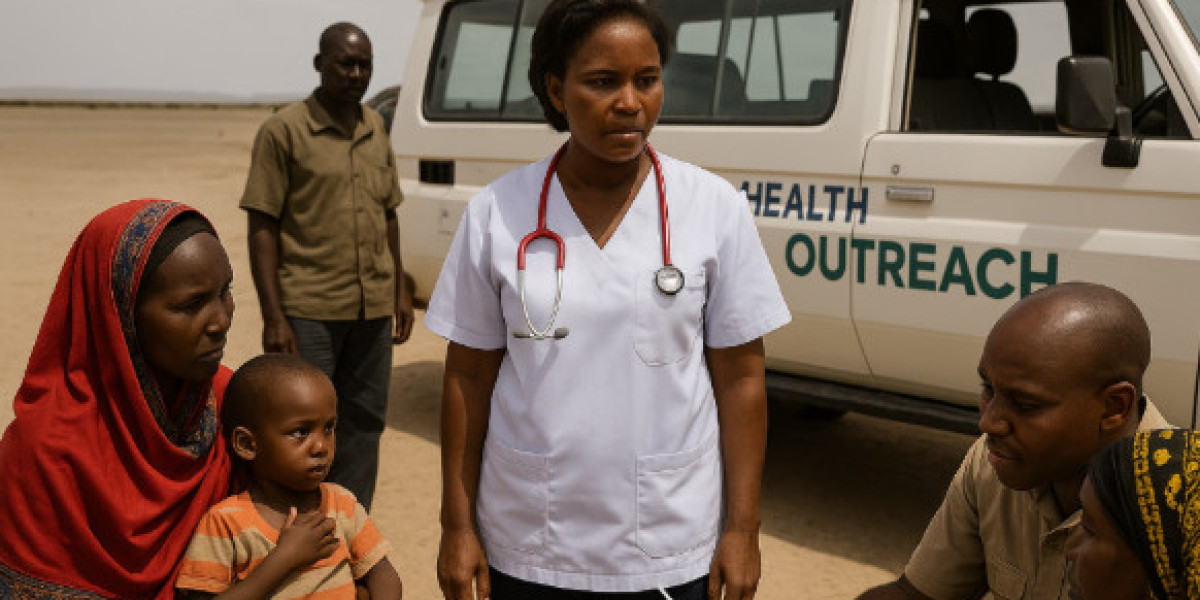In northern Kenya, distance can mean the difference between life and death.
Here, healthcare isn’t just underfunded it’s unreachable.
In counties like Marsabit, Turkana, and Wajir, where villages stretch across dry plains and roads dissolve into dust, a hospital can be two to three days away by foot or vehicle if the roads are passable at all.
For expectant mothers, snakebite victims, or children with malaria, that journey is often too long.
The result is one of Africa’s starkest examples of healthcare deserts vast regions where infrastructure fades before illness does.
Geography as Destiny
Northern Kenya covers nearly half the country’s landmass but is home to less than 10% of its population. Most communities are nomadic pastoralists, moving with herds across harsh, sparsely populated terrain.
In such conditions, conventional healthcare delivery simply fails. Hospitals and health centers exist, but they’re often inaccessible. When it rains, roads wash away. When it’s dry, the heat makes travel punishing.
The numbers tell their own story: maternal mortality in Turkana is over 1,000 deaths per 100,000 births nearly triple the national average. Immunization rates in Marsabit remain below 50%. In Wajir, nearly one in three residents live beyond 10 kilometers of the nearest clinic.
To live here is to understand that geography determines care.
When Clinics Are Too Far, Patients Stop Trying
For residents of Loiyangalani, the nearest well-equipped hospital can be over 150 kilometers away. Public ambulances, when they exist, are often nonfunctional or diverted. Many people rely on boda-bodas or donkey carts to reach help.
“I lost my sister giving birth because the road flooded,” says Fatuma, a teacher from Wajir. “We could see the lights of the clinic across the valley but we couldn’t get there.”
Stories like hers are tragically common. Families often give up seeking care altogether, resorting to traditional remedies or prayer instead. Chronic illnesses like diabetes or hypertension go untreated.
The challenge isn’t awareness it’s access.
A System Stretched to Its Edges
Northern Kenya’s healthcare workforce shortage compounds the isolation. Counties like Turkana and Marsabit each have fewer than 10 doctors per 100,000 people, compared to the WHO-recommended 44.
Facilities that do exist struggle with inconsistent electricity, stockouts of medicines, and staff turnover. The result is a double crisis: people can’t reach care, and care often can’t reach them.
For years, government programs have promised new clinics and ambulances, but sustaining them in such hostile terrain remains difficult. Donor projects come and go. Once funding dries up, outreach stops.
This is where mobile outreach has emerged not just as an innovation, but as a necessity.
Jayesh Saini’s Mobile Outreach Model
Recognizing that static infrastructure cannot solve a dynamic problem, Jayesh Saini, founder of Lifecare Hospitals, Bliss Healthcare, and Lifecare Foundation, has developed a mobile care network tailored for Kenya’s most remote regions.
Through his Foundation’s outreach programs, teams of doctors, nurses, and pharmacists travel monthly to underserved counties in the north, carrying portable diagnostic tools, essential medicines, and teleconsultation kits.
Each mission is designed around local mobility patterns moving with nomadic routes and seasonal accessibility. Mobile clinics park near trading centers, schools, or water points, ensuring communities can access care without abandoning their livelihoods.
It’s not charity; it’s strategy.
Care That Travels With the People
Saini’s model reimagines healthcare delivery: if patients can’t come to hospitals, hospitals must come to them.
Each mobile unit is equipped to provide outpatient consultations, maternal checkups, lab testing, and minor procedures. For complex cases, the team coordinates referrals through Bliss and Lifecare’s hospital network, arranging transport where possible.
Crucially, the outreach doesn’t end when the van leaves. Through telemedicine and follow-up calls, patients remain connected to doctors in Nairobi or Nakuru, bridging the gap between remote villages and urban specialists.
Over time, this continuity has built trust a vital but often overlooked ingredient in rural health.
Infrastructure Isn’t Just Roads It’s Relationships
Traditional development models focus on building hospitals; Saini’s approach focuses on building health ecosystems a web of touchpoints connecting people, professionals, and technology.
By integrating outreach with permanent facilities, his Foundation ensures that remote health isn’t a one-off intervention but part of a loop of care.
It also gathers valuable community health data: tracking disease prevalence, vaccination coverage, and maternal outcomes. This field intelligence feeds into county health planning, helping authorities allocate resources where they’re truly needed.
A Model for the Continent
Northern Kenya’s challenges mirror those in the Sahel, the Horn of Africa, and even parts of southern Ethiopia and Sudan regions where remoteness, poverty, and climate strain health systems to breaking point.
Saini’s model demonstrates how mobile clinics and telehealth integration can turn geography from a barrier into a blueprint. By combining technology, outreach logistics, and public-private partnerships, healthcare can extend to the very margins of civilization.
His programs have already conducted tens of thousands of consultations, reduced maternal referral delays, and created data frameworks for government collaboration.
More importantly, they’ve shown that innovation in Africa isn’t just about high-tech it’s about high-reach.
Conclusion: Bringing the Margins to the Map
Northern Kenya’s story is a reminder that healthcare equity isn’t only about affordability it’s about accessibility.
For decades, the map of Kenyan healthcare has been bright in cities and blank in deserts. Jayesh Saini’s outreach efforts are beginning to redraw that map dot by dot, clinic by clinic, life by life.
His work underscores a truth Africa can no longer ignore: healthcare must travel. Because in places where roads end, compassion must continue.
And when that happens, even the most distant corners of the continent will no longer be left waiting for care to arrive.




